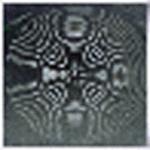Corneal topography simplifies soft toric fitting
Click Here to Manage Email Alerts
LANSING, Mich.—The increasing power of corneal topographers and their interpretive software can simplify the soft toric lens fitting process, saving optometrists time and helping with difficult fits.
"For soft toric lens fitting, our simple goal is to provide the proper diopter power at the proper position," said Kenneth A. Lebow, OD, at the Michigan Contact Lens and Primary Care Seminar held here.
However, there are a number of concerns in reaching this goal, such as lens rotation, lens position and eye/lens flexure. "Without topography," Lebow said, "we need to do a complicated and time-consuming spherical/cylindrical overcorrection."
Lebow, who practices in Virginia Beach, said there are a few basic philosophies in predicting success with soft toric contact lenses: spherical lenses do not mask corneal astigmatism; toric lenses should neutralize all corneal astigmatism; the in-situ topography map over the contact lens should appear relatively spherical; and when residual astigmatism is present, the map should show an equal but opposite power on the front surface of the lens.
In refuting the "so-called masking effect," he cited studies that revealed that masking of toric corneas by spherical lenses was thickness-related, and corneal maps reveal the same amount of astigmatism in astigmatic eye surfaces with spherical lenses.
First measure corneal surface
 --- 1:56 PM: Photokeratoscope--Decentered image, anterior lenticular bowl effect.
--- 1:56 PM: Photokeratoscope--Decentered image, anterior lenticular bowl effect.
When fitting soft torics, Lebow said first he measures the corneal surface and fits a diagnostic lens. Then he measures the in situ diagnostic contact lens surface. The objective, he said, is for the computer to compare both surfaces and create a difference map. "We should evaluate the corneal power maps in terms of neutralizing the ocular surface," said.
 --- 12:07 PM: Photokeratoscope--Centered image, good focus
--- 12:07 PM: Photokeratoscope--Centered image, good focus
To illustrate, Lebow said that a patient who has a with-the-rule corneal surface, when mapped with an in situ soft toric lens, should demonstrate an against-the-rule surface on the front of the eye, the equal but opposite principle.
"Just as we utilize fluorescein and the biomicroscope in rigid lens fitting to evaluate the lens fit," Lebow said, "corneal topography is the tool to evaluate soft toric lens fitting and the effect of flexure on the eye of different types of soft lenses with the corneal surface and the lid pressures that are placed on it."
Maps help with small axes of change
Topography is particularly useful when evaluating the effect of lenses on small changes in axis. "There are clinical ways of dealing with these situations that we really don't have a definitive answer for," he said. "The maps give a definitive answer."
Topographers also offer optometrists substantial time savings. "Topography maps will give you information up front," Lebow said, "so you can see a better fitting relationship and a better lens design in terms of distortion or defective lenses and better axis orientation coincident with the axis of the ocular surface."
Topography is also technician-intensive: "You look at the fit of the lens--all of the other data is gathered for you," he said.
Lebow warned about erroneous data when looking at the maps. For instance, topographer dots projected onto the edge of the lid can create a much flatter curve as the computer's algorithm is thrown off. Lens decentration is also a concern, as it makes data collection much more difficult.
And sometimes focusing can be complicated. "There is a certain depth of focus that you can deal with in these maps," Lebow said. "If you go beyond that you lose the clarity of the image."
This is because most toric lenses have a thicker optical cap that protrudes anteriorally toward the placido image.
Smart practice management
In addition to the valuable fitting information a topographer can provide, Lebow said he has also found that patients "have been extremely impressed with the capabilities and technologies. From a management standpoint, they're going to tell other patients, and it's going to stimulate more interest in your practice."
Lebow says that in the future after comparing the two readings, optometrists will simply "push a button on the topographer" and the machine will give lens choices.
Presently, however, soft toric lens fitting with corneal topography is still in its embryonic stages. "All of this information has to be condensed into a computer language so the computer knows what to suggest and what to consider."
